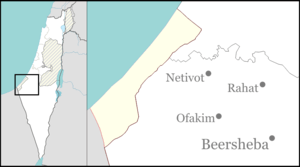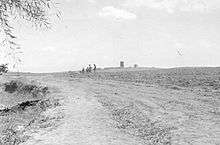Mishmar HaNegev
Mishmar HaNegev (Hebrew: מִשְׁמַר הַנֶּגֶב, lit. Guard of the Negev) is a kibbutz in the northern fringe of the Negev desert in Israel. Located on Road 264, about two kilometres south of the Bedouin city of Rahat and around ten kilometres from Beersheba, it falls under the jurisdiction of Bnei Shimon Regional Council. In 2018 its population was 933.[1]
Mishmar HaNegev מִשְׁמַר הַנֶּגֶב | |
|---|---|
.jpg) Mishmar HaNegev in 1950 | |
 Mishmar HaNegev | |
| Coordinates: 31°21′51.48″N 34°43′7.31″E | |
| Country | Israel |
| District | Southern |
| Council | Bnei Shimon |
| Affiliation | Kibbutz Movement |
| Founded | 6 October 1946 |
| Founded by | Borochov movement members |
| Population (2018)[1] | 933 |
| Name meaning | Guard of the Negev |
History
Mishmar HaNegev was founded in 1946 as one of the 11 points in the Negev settlements. It was settled by members of Borochovi Youth, a youth group affiliated with Poalei Zion, who set up camp at the site on the evening of October 6, just after the Yom Kippur fast. In 1994, privatization process began in the kibbutz and in 2004 the kibbutz members voted to change the rules radically towards total privatization.[2]
Economy
Mishmar HaNegev is the owner of Polybid Expanded Polystyrene Products, which produces insulation products for Israel and Eastern Europe. The company has an annual turnover of NIS 100 million.[3] Mishmar HaNegev and Ecological Services Ltd. established a joint company, Negev Ecology, that operates a shredding and burial facility for tire waste materials. The shredding mill can shred eight tons of tires an hour into 10x5 cm. rubber strips that are buried at a toxic waste site in southern Israel.[4]

Notable residents
- Eliezer Rafaeli (born 1926), founding President of the University of Haifa
References
- "Population in the Localities 2018" (XLS). Israel Central Bureau of Statistics. 25 August 2019. Retrieved 26 August 2019.
- Crumbling along with the ideology that built it, Haaretz
- Tene pursues kibbutz factories, Haaretz
- Ecological service